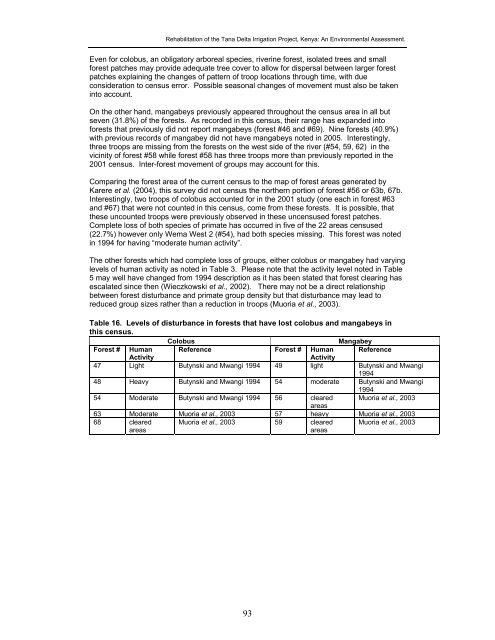Tana Delta Irrigation Project, Kenya: An Environmental Assessment
Tana Delta Irrigation Project, Kenya: An Environmental Assessment
Tana Delta Irrigation Project, Kenya: An Environmental Assessment
Create successful ePaper yourself
Turn your PDF publications into a flip-book with our unique Google optimized e-Paper software.
Rehabilitation of the <strong>Tana</strong> <strong>Delta</strong> <strong>Irrigation</strong> <strong>Project</strong>, <strong>Kenya</strong>: <strong>An</strong> <strong>Environmental</strong> <strong>Assessment</strong>.<br />
Even for colobus, an obligatory arboreal species, riverine forest, isolated trees and small<br />
forest patches may provide adequate tree cover to allow for dispersal between larger forest<br />
patches explaining the changes of pattern of troop locations through time, with due<br />
consideration to census error. Possible seasonal changes of movement must also be taken<br />
into account.<br />
On the other hand, mangabeys previously appeared throughout the census area in all but<br />
seven (31.8%) of the forests. As recorded in this census, their range has expanded into<br />
forests that previously did not report mangabeys (forest #46 and #69). Nine forests (40.9%)<br />
with previous records of mangabey did not have mangabeys noted in 2005. Interestingly,<br />
three troops are missing from the forests on the west side of the river (#54, 59, 62) in the<br />
vicinity of forest #58 while forest #58 has three troops more than previously reported in the<br />
2001 census. Inter-forest movement of groups may account for this.<br />
Comparing the forest area of the current census to the map of forest areas generated by<br />
Karere et al. (2004), this survey did not census the northern portion of forest #56 or 63b, 67b.<br />
Interestingly, two troops of colobus accounted for in the 2001 study (one each in forest #63<br />
and #67) that were not counted in this census, come from these forests. It is possible, that<br />
these uncounted troops were previously observed in these uncensused forest patches.<br />
Complete loss of both species of primate has occurred in five of the 22 areas censused<br />
(22.7%) however only Wema West 2 (#54), had both species missing. This forest was noted<br />
in 1994 for having “moderate human activity”.<br />
The other forests which had complete loss of groups, either colobus or mangabey had varying<br />
levels of human activity as noted in Table 3. Please note that the activity level noted in Table<br />
5 may well have changed from 1994 description as it has been stated that forest clearing has<br />
escalated since then (Wieczkowski et al., 2002). There may not be a direct relationship<br />
between forest disturbance and primate group density but that disturbance may lead to<br />
reduced group sizes rather than a reduction in troops (Muoria et al., 2003).<br />
Table 16. Levels of disturbance in forests that have lost colobus and mangabeys in<br />
this census.<br />
Colobus<br />
Mangabey<br />
Forest # Human Reference Forest # Human Reference<br />
Activity<br />
Activity<br />
47 Light Butynski and Mwangi 1994 49 light Butynski and Mwangi<br />
1994<br />
48 Heavy Butynski and Mwangi 1994 54 moderate Butynski and Mwangi<br />
1994<br />
54 Moderate Butynski and Mwangi 1994 56 cleared Muoria et al., 2003<br />
areas<br />
63 Moderate Muoria et al., 2003 57 heavy Muoria et al., 2003<br />
68 cleared<br />
areas<br />
Muoria et al., 2003 59 cleared<br />
areas<br />
Muoria et al., 2003<br />
93

















